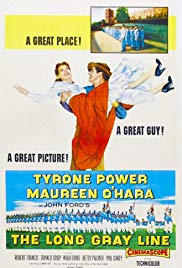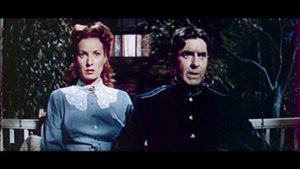The Long Gray Line *** (1955, Tyrone Power, Maureen O’Hara, Robert Francis) – Classic Movie Review 9431
John Ford’s 1955 biopic The Long Gray Line is a rambling, amiable, catch-in-the-throat toast to West Point coach Marty Maher (Tyrone Power) and his 50 years at the renowned military academy.
An apparently well-cast Power turns out to be stiff as the hero, allowing Maureen O’Hara to take the acting honours as his wife Mary O’Donnell, in this long and episodic tale of glory and defeat, though the Ford repertory company of players makes its mark too.
Marty Maher is an Irish immigrant taken on in 1898 as a civilian employee at West Point where he rises to NCO and instructor.
The Long Gray Line is in many respects a typical work of its esteemed director, as a tale of Irish Americans, and to be admired as such, but it is not one of Ford’s great films. It is his first movie in CinemaScope, which he hated.
Edward Hope’s screenplay is based on Marty Maher’s autobiography Bringing Up the Brass, written with Nardi Reeder Campion.
Also in the cast are Robert Francis, Ward Bond, Donald Crisp, Betsy Palmer, Philip Carey, William Leslie, Peter Graves, Harry Carey Jr, Sean McClory, Milburn Stone, Erin O’Brien-Moore, Walter Ehlers and Patrick Wayne.
The Long Gray Line is directed by John Ford, runs 137 minutes, is made by Rota Productions and Columbia Pictures, is released by Columbia Pictures, is written by Edward Hope, is shot in Technicolor and CinemaScope by Charles Lawton Jr, is produced by Robert Arthur, is scored by George Duning and is designed by Robert Peterson.
The West Point location filming took place in summer when most cadets were gone to avoid disrupting their routine.
© Derek Winnert 2020 Classic Movie Review 9431
Check out more reviews on http://derekwinnert.com



